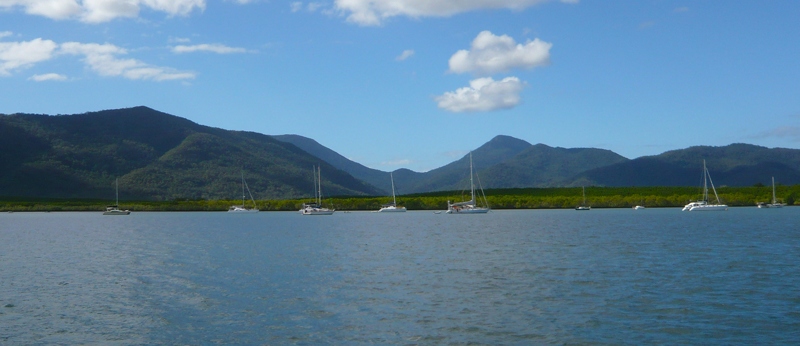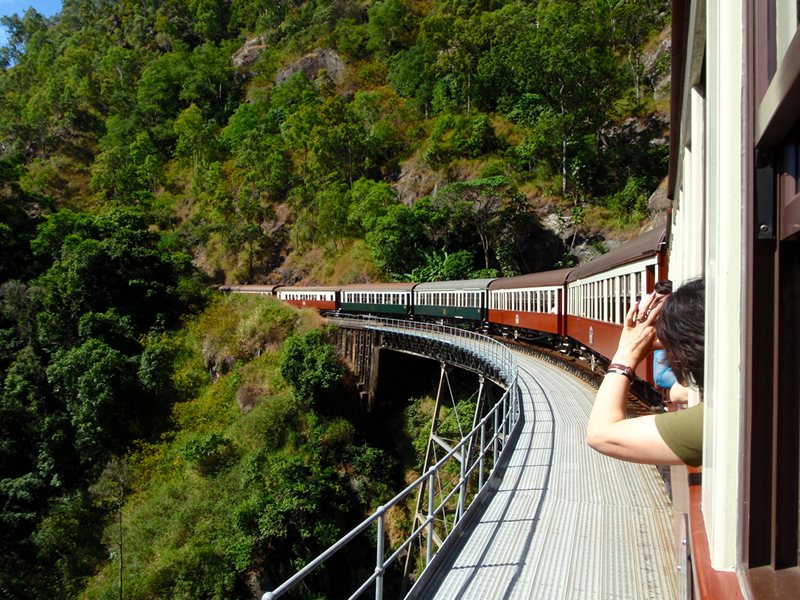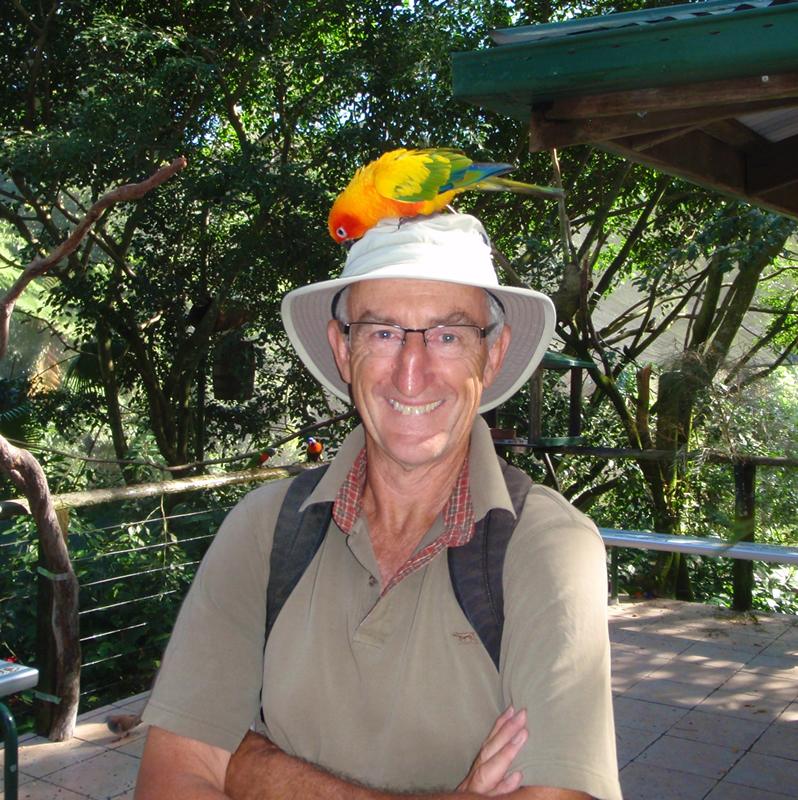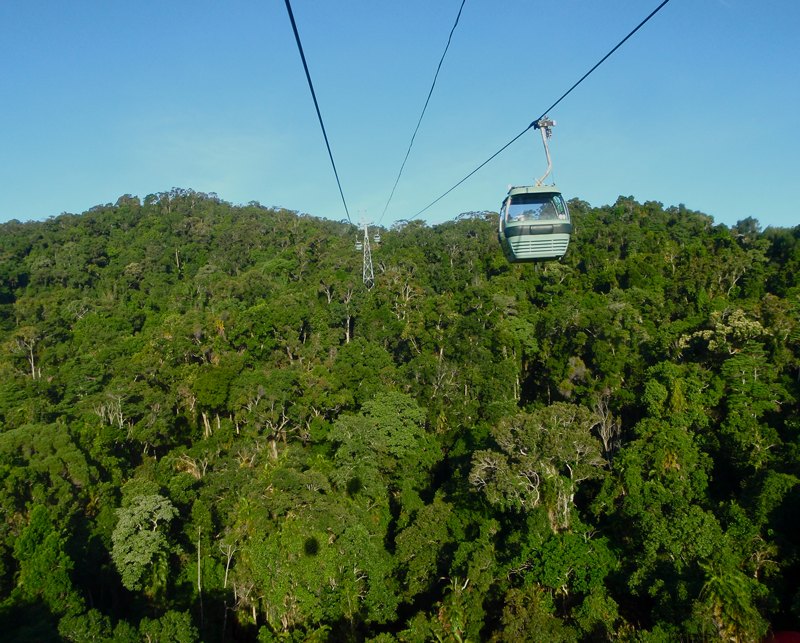Third Time's a Charm - Marlin Marina, Cairns, Queensland, Australia

Harmonie
Don and Anne Myers
Sun 11 Jul 2010 01:17
|
16:55.106S 145:46.913E
Ok. Finally. As promised, here's the
gory details of our sail up and over the top of Australia.
Starting with Cairns.
We arrived in Cairns (pronounced 'Cans') waaaay
back when on June 4th and stayed four days - just long enough to stock up on
food, fuel and wine, see the sights, and get the generator exhaust system
'sorted' (translation from Aussie-talk: fixed or figured out).
Correction: long enough for Don to get the generator exhaust system sorted
and for me to see the sights. The only sights Don saw during our four-day
Cairns stay were the inside of two restaurants and
two chandleries, and the inside of the engine compartment.
We found Cairns and the Marlin Marina to be much
nicer, more vibrant and more beautiful than we expected, and would have stayed
longer, but after assessing our sailing-progress-to-Darwin situation, we
decided we had better get a move on. At that point, we still had 1300
miles to go and only three weeks to do it in. This, after taking a very
leisurely seven weeks to sail the 700 miles from Brisbane to Cairns. The
speed at which time slips by while cruising around on a sailboat never
ceases to amaze us. Occasionally though, reality pokes through the
happy haze in which we live, and we realize it's time to
stop lollygagging about and get serious about this sailing thing.
So. Cairns. According to the Lonely
Planet, Cairns has a population of 120,000, whereas Mackay, the
previous city-port we visited, is reported as having only
80,000. Both are growing cities, but each in its own way. Mackay is
all about mining. Cairns is all about tourism. Mackay is gritty,
with people on a mission bustling through its 4-by-4 grid of streets lined with
3-story Victorian buildings complete with iron lace lined balconies.
Downtown Cairns has a 7x7 grid of streets, and is glitzy with modern hotels
and a casino rising well above street level. Mackay is the gateway to the
Whitsunday Islands, whereas Cairns is the gateway to the Great Barrier
Reef. While it's true the Great Barrier Reef stretches down the
coast to a point slightly south of Mackay, it's angled, so as you
move north up the coast, the reef gets closer and closer to the mainland.
By the time you reach Cairns, the reef is a short 15 miles away. For
the tourist, Cairns is a lovely spot with mountains spiraling up a short
distance inland and the reef only a short distance out to sea. For the
cruising sailor, Cairns is a lovely spot with the marina only a block away from
the heart of the city and a boardwalk lined with restaurants two steps away from
the docks. Most importantly, there was a very good ice cream shop about
ten paces away from the end of our dock and a hairdresser within three
blocks. Oh yeah, and the welder needed to fix our
generator's exhaust system was only a short drive away.
Cairns was the first place we'd been along the
Australian east coast where lots of foreign boats like us
were gathered. It's just about the last stop in civilization
before the long slog up and over the top of Australia to Darwin, so boaters like
us tend to stop here for a while to bask in the glow of as many cabin
lights as we please since there is no need to worry
about sucking up battery power when plugged into the land power grid. Tied
to docks floating in extremely calm water also has its appeal to those
who are weary of midnight washing machine episodes caused by severe wind
against tide phenomena in certain anchorages.
In Cairns we caught up with friends we hadn't
seen in a long time and met other boaters headed
for Indonesia. Don and I were working on boat jobs one day at the
marina when we heard a woman say, "Harmonie! Are you the same Harmonie
that was in the World ARC rally?". We popped our heads out of the
cabin and there she was, a blast from the World ARC past, Jean. Jean,
who was a crew member for much of the trek across the Pacific on rally boat
Graptolite, owned by Martin Pickup, the retired British geologist best known for
his half-naked appearance at the Bora Bora farewell party in the Society Islands
of French Polynesia. The last time we saw Jean was two years ago in the
anchorage just outside of the Musket Cove Marina in Fiji. We were
just leaving for Tanna, Vanuatu (that fateful, rollicking trip that
still holds our record for the longest period of sustained winds
over 35 knots), and Jean was just arriving on a boat in the
rival Bluewater rally (she had jumped ship from Graptolite in Tonga or
Fiji). So, just like that, two years and several thousand miles
later, a boater from the past pops up again. This slowly
rotating brother and sisterhood of circumnavigating sailors has a way
of continuously surprising us. Which means the age-old traveling adage,
"Don't worry, you'll never see these people again." is most definitely not true
in our case.
Now, about the welder and our generator's exhaust
system. We arrived at the Marlin Marina in Cairns on a Friday morning, and
Don was thrilled when he spoke to a local welder who agreed to fix the offending
part for us that day. True to his word, the re-welded part was delivered
to Don by sunset that night (6pm in these tropical parts) for a mere $60
(chicken feed in the world of marine repairs). We celebrated over
dinner. The next morning, Don attempted to re-fit the part into the
exhaust system and discovered that the new weld was ok, but the stainless steel
plate that the tube was welded to was cracked. Back to the welder Don
went. This time, it was decided that the steel plate had to
be replaced. The welder agreed to fabricate a new plate and weld
it to the tube. The newly fabricated and welded part was back in Don's
hands on Sunday for a mere $450 (slightly more than chicken feed in the world of
marine repairs). We celebrated over dinner. The next day, Don
re-fitted the part only to discover that one of the welds was bad. On
Monday, back to the welder Don went. The welder agreed to fix the
weld. Tuesday morning, Don went to the welder, inspected the part
when it was finished, deemed it okey-dokey, paid $0, and brought it back to the
boat where he installed it. By 11:20 that morning we were on our
way. We celebrated over lunch. In this case, the age-old adage,
"Third time's a charm!" was true.
While Don was traipsing back and forth to the
welder and climbing in and out of the engine compartment, I was romping
around the countryside with Sue, Annette and Tony. Below are
pictures.
Picture 1 - Anchorage just outside the Cairns approach channel with the Great
Dividing Range in the background.
Picture 2 - Approaching the marina on the
right and passing one of the fast-cat tourist boats headed to
the barrier reef.
Pictures 1 and 2 were taken by Helen, who
is one-half of the third set of Storyteller guests. Ray and Helen
arrived in Cairns about the same time that Annette and Tony left
for New Zealand. Ray and Helen spent time on Storyteller last year in
Vanuatu and New Caledonia, and also hosted us along with John and Sue in
their Flinders country home during our Australian land tour earlier this
year. These pictures are two of many I borrowed from Helen's far
superior collection of Cairns-to-Darwin pictures.
Picture 3 - The Kuranda Scenic Railway. Tony,
Annette, Sue and I, along with Dave and Jan from the American boat
Baraka, rode the train up into the mountains to the historic town of
Kuranda. Kuranda existed as a booming mining town and drove the
development of Cairns as the most convenient port back in the late
1800's. Over the last century, Kuranda has been reduced to a
quaint tourist town, while Cairns has taken over as the main
attraction.
Picture 4 - The Barron Falls. The winter here
(June, July and August) is also the dry season, so the flow over the 265 meter
falls drop isn't spectacular, but the Barron Gorge is still pretty.
The train to Kuranda winds along the side of the gorge, and the views were
excellent out the open window as long as you didn't mind the steep ascent, the
creaking wooden railcars or the frequent plunges into darkness as the train
muscled through the fifteen small, hand-hewn tunnels.
Picture 5 - Tony, quite happy to have a sun conure
bird perched on his head at Birdworld, one of the tourist attractions in
Kuranda. Annette and I opted to employ umbrellas to ward off potential
perching and pooping. Sue pooh-poohed the umbrellas and persevered through
Birdworld with no perching or pooping protection. In the end, she happily
emerged unscathed.
Picture 6 - The Rainforest Cableway. Up in
the train, down in the gondola, skimming the tops of the rainforest
canopy. Everyone was happy in our 6-person gondola until it stopped
and creaked up and down over a river known to be a home for
crocodiles. We had visions of a mid-air rescue when
an announcement came over the PA system declaring the cableway was
experiencing a 'technical problem'. Ten or fifteen minutes later and lots
of deep breathing on Annette's part, and we were underway again. Good
thing too because Dave was threatening to unpack his newly purchased didgeridoo
(Aboriginal musical instrument made from a hollowed out tree limb that if
played well, emits a twanging, vibrating, haunting, base sound often heard in
movies depicting Australian scenes) and serenade us.
More on our whirlwind Cairns-to-Darwin expedition
later.
Anne
|





